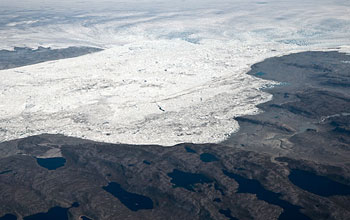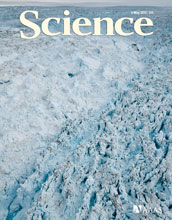All Images
News Release 12-088
Analysis of Speed of Greenland Glaciers Gives New Insight for Rising Sea Level
Researchers determine that although glaciers continue to increase in velocity, the rate at which they can dump ice into the ocean is limited
This material is available primarily for archival purposes. Telephone numbers or other contact information may be out of date; please see current contact information at media contacts.

The north branch of Jakobshavn Isbrae is in the upper left corner of the image, with several newly calved icebergs in front of it. The larger, faster moving, south branch is located near the upper right corner. Prior to about 2003, both branches merged to create a large floating ice tongue that extended beyond the iceberg covered area visible in this image. Since the 1990, the glacier calving front (terminus) has retreated about 18 km (11 miles). Now, it is only in the winter that both branches sometimes merge to form a much smaller seasonal ice tongue, which breaks up in the spring.
Credit: Polar Science Center, Applied Physics Laboratory, University of Washington
Download the high-resolution JPG version of the image. (178 KB)
Use your mouse to right-click (Mac users may need to Ctrl-click) the link above and choose the option that will save the file or target to your computer.

The researchers' work is described in the May 4, 2012 issue of the journal Science.
Credit: Copyright AAAS 2012
Download the high-resolution JPG version of the image. (1.3 MB)
Use your mouse to right-click (Mac users may need to Ctrl-click) the link above and choose the option that will save the file or target to your computer.


